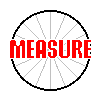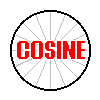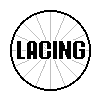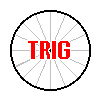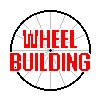



















| |
| |




















|
FIXES FOR SOME PROBLEMS




















| |
| |




















|
If you end up with spokes that are too long or too short, you can still possibly use them, but not exactly like you wanted. You can always go buy the correct length after you figure out the proper length they need to be, but if you need the wheel right away, or if you don't want to waste the spokes, there are a few things you can do. If you want the wheels perfect and you get new spokes, save the wrong ones (if they were to deformed from the attempted wheel build to exchange) so you can use them in a different wheel later.
If the spokes are only a little too long and stick up past the nipple, where they could go through a rim strip and puncture a tube, you can get by with extra rim tape. By 'a little' I mean one or two millimeters and you were able to properly tension the wheel. Use two cloth rim tapes, not the rubber kind. With two layers of rim tape, it is unlikely that the spoke ends will be able to cut through and puncture the tube. The rubber strips cut easy and the spoke ends probably would cut through after a while. This wouldn't be a problem with rims that have the nipple seats recessed past an inner surface, only with rims where the spoke holes go through only one layer of metal making up the center of the rim, so the tube can press directly on the nipple.
If the spokes are too long by 4mm or 5mm, then a way to fix the problem would be to re-lace the wheel with one more spoke crossing. A typical 32 hole front hub changes spoke length about 6mm between a 2-cross and a 3-cross or a 3-cross and a 4-cross. When you change the lacing you will only need to fully unlace half the spokes. The spokes coming around the outside of the hub flanges will be the easiest to do this to. Unlace those spokes on both sides and then re-lace them with the new pattern. Watch out for the valve hole!
If the spokes are just a little too short, 2mm or 3mm, you could still lace the wheel the way you wanted to using the hint for starting short spokes in the SPOKE LENGTH TOLERANCE chapter.
If the spokes are 4mm or 5mm too short, so the wheel couldn't be properly started, you can get by with one less cross. Unless the spokes were for a radial lacing. Follow the suggestion above for spokes that are too long only subtract one crossing from the pattern.
If you were going to lace the wheel with a 2-cross pattern and the spokes are too short and you decided to go to a 1-cross pattern, there are two ways to do this. First off a 1-cross pattern shouldn't have greased nipples for the same reasons as radial lacing, so clean off any grease the best you can. You can lace a 1-cross wheel either so all of the spokes come off the same side of a flange, or alternate sides like in a standard cross laced wheel. If you alternate the sides of the flange, do not let the crossing spokes physically touch, the bend that would result would be too sharp and create a high pressure point. If all the spokes came off the same side of the flange, the crossing would be OK, just possibly a little hard to work with.

